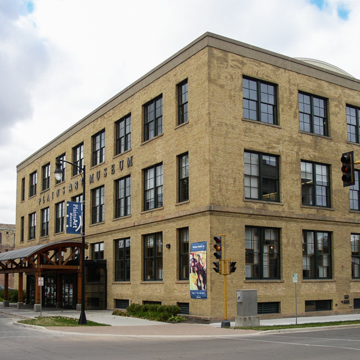You are here
Plains Art Museum (International Harvester Branch House)
One of the most archetypal of the “machinery row” buildings constructed for agricultural machinery distribution was designed by a company engineer. It is an unpretentious classical building that was originally ornamented with a projecting cornice and rooftop illuminated-neon scaffold sign. The former showroom sales floor and upper-story assembly floors are excellent examples of a heavy timber-framed structure with 16 × 16-inch fir columns and paired 6 × 14-inch girders. Brick arches are above the windows on the secondary, west elevation, but more technically progressive flat steel lintels are used on the street-side display windows.
As impressive as is the interior, the design for the conversion of this industrial building into the Plains Art Museum (PAM) is equally remarkable. Between 1991 and 1993, PAM evaluated potential building sites for relocating their major regional collection. The design makes effective use of a three-story interior atrium for daylighting of the gathering spaces that surround the core of art galleries. Interior partitioning defers respectfully to the historic timber frame and wood decking. A gallery reopening exhibit in 1995 called attention to the preservation ethic and drew comparisons between the building’s historic and contemporary uses. This project is one of the state’s most successful adaptive reuses in a public building.
Writing Credits
If SAH Archipedia has been useful to you, please consider supporting it.
SAH Archipedia tells the story of the United States through its buildings, landscapes, and cities. This freely available resource empowers the public with authoritative knowledge that deepens their understanding and appreciation of the built environment. But the Society of Architectural Historians, which created SAH Archipedia with University of Virginia Press, needs your support to maintain the high-caliber research, writing, photography, cartography, editing, design, and programming that make SAH Archipedia a trusted online resource available to all who value the history of place, heritage tourism, and learning.











